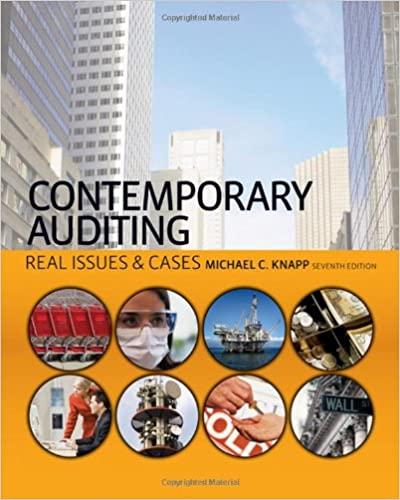In 1975, Carlos Cordova and several other investors founded Capital National Bank (CNB) in Bronx, New York.
Question:
In 1975, Carlos Cordova and several other investors founded Capital National Bank (CNB) in Bronx, New York. Cordova was appointed the bank's chief executive officer and chairman of the board. Over the next several years, the bank opened five branch offices in the New York City metropolitan area. CNB catered primarily to the banking needs of Hispanic-American and immigrant communities in New York City. In 1986, Cordova and the other owners of CNB formed CapitalBanc Corporation, a publicly owned bank holding company registered with the Securi- ties and Exchange Commission (SEC). Throughout its entire existence, the princi- pal operating entity controlled by CapitalBane was CNB. Cordova assumed the titles of president, chief executive officer, and chairman of the board of the new bank holding company.
In the fall of 1987. CapitalBanc retained Arthur Andersen & Co. as its indepen- dent audit firm. Andersen's first engagement for CapitalBanc was to audit the bank holding company's consolidated financial statements for the fiscal year ending December 31. 1987. Thomas Curtin, an Arthur Andersen partner since 1979, served as the engagement partner for the 1987 CapitalBanc audit. Curtin delegated the responsibility for much of the audit planning to James Lukenda, an audit manager with Arthur Andersen since 1983. Lukenda also supervised the staff auditors assigned to the CapitalBanc engagement.
In the fall of 1987. CapitalBanc retained Arthur Andersen & Co. as its indepen- dent audit firm. Andersen's first engagement for CapitalBanc was to audit the bank holding company's consolidated financial statements for the fiscal year ending December 31. 1987. Thomas Curtin, an Arthur Andersen partner since 1979, served as the engagement partner for the 1987 Capital Banc audit. Curtin delegated the responsibility for much of the audit planning to James Lukenda, an audit manager with Arthur Andersen since 1983. Lukenda also supervised the staff auditors assigned to the CapitalBanc engagement.
On December 29, 1987, several Arthur Andersen staff auditors accompanied members of CNB's internal audit staff to the bank's 177th Street Branch. The Arthur Andersen auditors intended to observe and participate in a surprise count of the branch's cash funds by the internal auditors. Related audit objectives included testing CNB's compliance with certain control procedures and evaluating the competence of the bank's internal audit staff.
The accounting personnel at each CNB branch maintained a "vault general ledger proof sheet" that reconciled the cash on hand to the balance of the branch's general ledger cash account. During the surprise cash count at the 177th Street Branch, the Arthur Andersen auditors discovered a \($2.7\) million reconciling item listed on the branch's proof sheet. That amount equaled 61 percent of the branch's general ledger cash balance and 45 percent of the branch's total cash funds that were supposed to be available on the date of the surprise count. When the staff auditors asked to count the \($2.7\) million of cash represented by the reconciling item, bank employees told them that Cordova had segregated those funds in a locked cabinet within the bank's main vault. Three keys were required to unlock the cabinet. Cordova, who was out of the country at the time, maintained custody of one of those keys.
Stymied temporarily one of the staff auditors telephoned Lukenda. The staff auditor relayed to Lukenda the information regarding the \($2.7\) million of segregated cash. After considering the matter and discussing it with Curtin. Lukenda instructed the staff auditor to count the cash upon Cordova’s return. Lukenda also reportedly told the staff auditor that it would not be necessary to place audit seals on the doors of the cabinet or to secure it in any other way given the three-key security system used by the branch. Following the telephone conversation with Lukenda, the staff auditor advised bank personnel that Arthur Andersen auditors would count the cash on the date Cordova returned from his trip.
CNB’s practice of segregating a large amount of cash in the locked cabinet was clearly not a normal banking procedure. In a subsequent investigation, the SEC commented on this practice:.........
Questions
1. When auditing cash, which of the management assertions discussed in SAS No. 106, “Audit Evidence; are of primary concern to an auditor? Why?
2. Identify audit procedures that should be applied to cash funds maintained by a client on its business premises.
3. Identify mistakes or oversights made by Arthur Andersen personnel while auditing the cash funds at the 177th Street Branch.
Step by Step Answer:

Contemporary Auditing Real Issues And Cases
ISBN: 9780324658057
7th Edition
Authors: Michael C. Knapp





